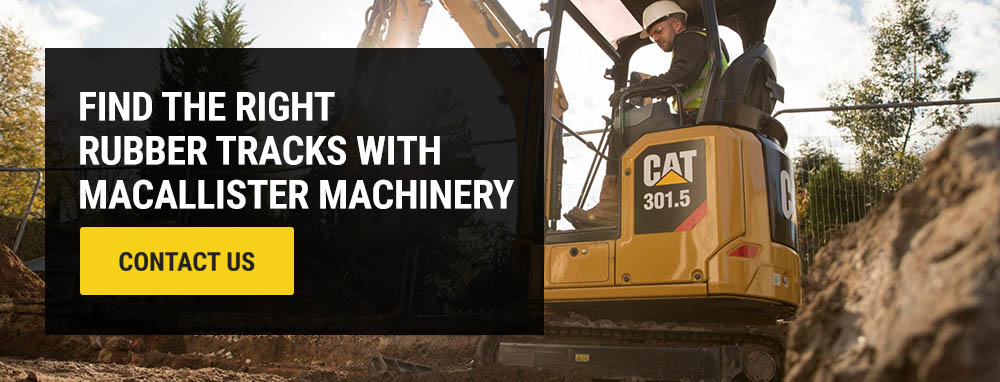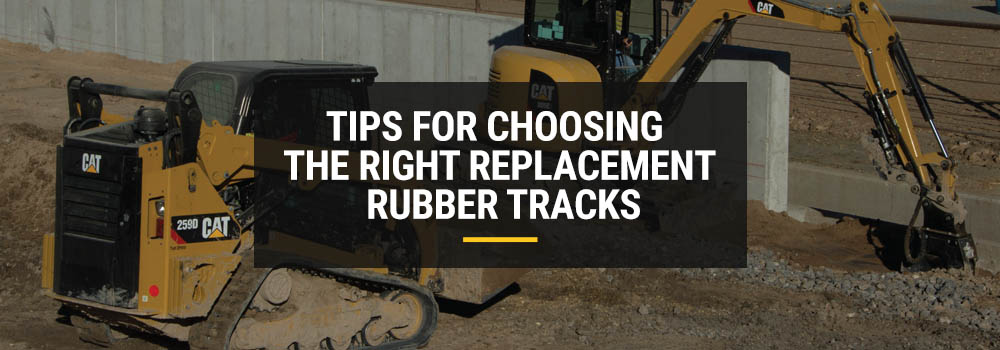
Mini excavator and compact track loader tracks must fit your application and job site conditions for optimal performance, desired results and equipment protection. Rubber track sizes, materials and tread patterns can alter how equipment operates on different terrain, so choosing the right tracks for your application and soil type is essential.
Jump to Sections:
- The Importance of Selecting the Right Tracks for Each Application
- Different Rubber Track Options
- Choosing the Right Rubber Track Size and Width
- Why Rubber Track Composition Matters
- OEM vs. Aftermarket Rubber Tracks
- Why You Should Always Replace Tracks in Pairs
- Tips for Choosing the Right Replacement Rubber Tracks
While some tracks maneuver smoothly over soft surfaces to leave minimal markings, others provide strong traction to keep equipment steady and balanced in slippery conditions. Various track tread patterns are available, enabling you to find the perfect tracks for a wide range of applications. Whether you perform snow removal, general construction, landscaping or agricultural tasks, an equipment expert can help you choose the best tracks.
The Importance of Selecting the Right Tracks for Each Application
Choosing the right replacement rubber tracks for your equipment offers the following advantages:
1. Lower Maintenance and Repair Costs
Changing your compact track loader or mini excavator tracks enables you to adapt your equipment to new terrain and reduce wear. Choosing the right tracks helps prevent damage, lowering your maintenance and repair costs. The longer your tracks and equipment operate at top performance, the more money you can save on upkeep.
2. Equipment Longevity
Reducing wear and preventing damage with the right tracks also helps you extend your equipment’s longevity. Rather than replacing your equipment frequently, you can expect it to last longer and provide you with a higher return on investment (ROI).
3. Greater Efficiency and Productivity
Choosing the right tracks for each application can boost efficiency and productivity. Enhancing your equipment’s performance enables your team to use it more quickly and easily, which makes jobs simpler and helps you meet project deadlines.
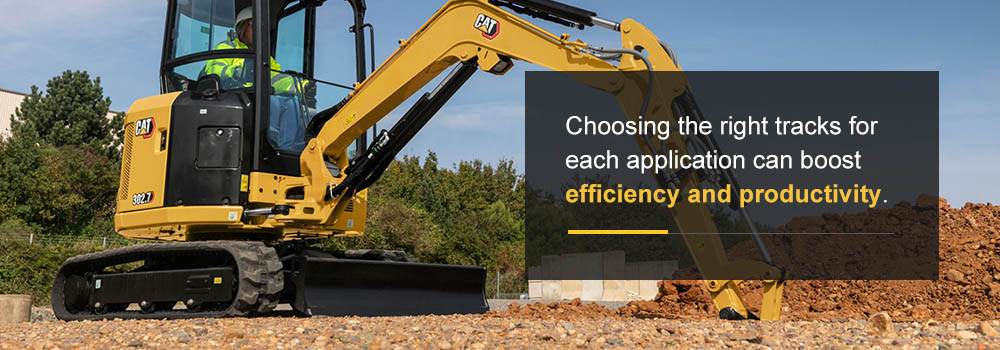
4. Protection of Job Site Surfaces
Equipping your mini excavator or track loader with the right tracks helps protect your job site’s surfaces. For example, using wide tracks with the right tread pattern allows your equipment to “float” over surfaces with minimal damage, leaving little to no tread marks or grooves behind.
5. Safety
Equipment tracks are also an essential safety consideration. Fitting your mini excavator or skid loader with the right tracks for your application and work site terrain protects you and your team from potential accidents.
You can prevent equipment from sliding on wet, muddy, icy or snow-covered surfaces with the right traction, ensuring you keep yourself and your employees as safe as possible. It’s also important to ensure your team understands and practices safe driving and operation tactics when working in snowy, icy or muddy conditions.
6. Better Project Results
The tracks you use on your equipment can also affect your work, helping you avoid mistakes. For example, using tracks meant for soft surfaces when landscaping prevents you from damaging a client’s lawn. Delivering quality results on time pleases clients and increases the likelihood they recommend your services to others.
Different Rubber Track Options
Choosing tracks with the right tread helps extend your tracks’ life span, increase operator comfort and boost production. Consider which of the following track options is best for you based on applications and hours of use:
1. Block Tread
As the most common rubber track tread pattern, block tread works well in various conditions. It’s especially useful on gravel, finished lawns, sand, clay, asphalt, mud and heated paved surfaces. The block tread pattern features large block-shaped pads in a straight or staggered arrangement.
2. Straight Bar Tread
The straight bar tread pattern features slimmer pads and offers excellent traction, a smooth ride and dependable dirt compaction. It’s an excellent option if you often use your track loader or mini excavator on muddy or wet surfaces. This type of track maximizes traction and reduces the risk of getting your equipment stuck in challenging terrain. Straight bar tracks have a lower durometer rating than other track types, making them less likely to shred or tear up finished turf.
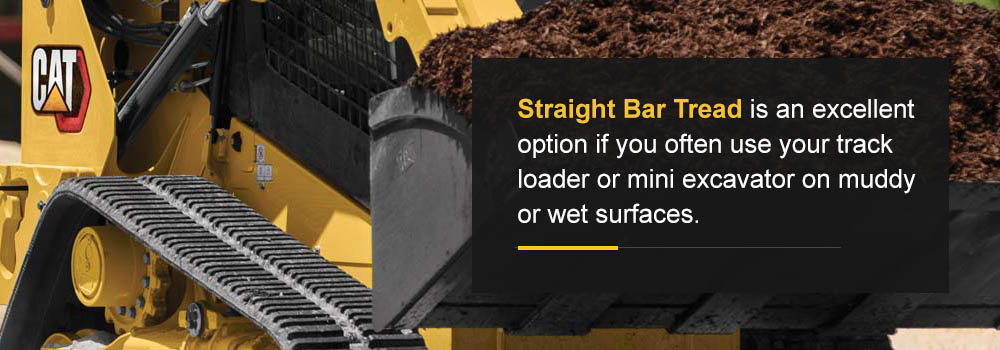
3. Multi-Bar
Tracks with a multi-bar lug pattern provide high-performance traction and durability in muddy, wet conditions. A multi-bar track features two rows of slim pads, and it’s an all-season read pattern that reduces wear and extends performance life on flat, hard surfaces. While it’s not the ideal choice for rocky conditions, it’s a fantastic option if you plan to work in dirt and sand or complete general construction work. Multi-bar lug pattern tracks typically have 800+ hour ratings.
4. Standard C-Pattern
The standard C-pattern track tread is a highly versatile option offering traction and durability each season. As its name implies, the standard C-pattern tread design features two rows of C-shaped pads. While it’s not ideal for snow, it’s a great option for working in mud and dirt. You can expect an 800+ hour rating from standard C-pattern tracks.
5. Premium C-Pattern
Premium C-pattern tread tracks feature larger C-shaped pads and provide excellent traction for ground surfaces such as mud, dirt and rocky terrain. A C-pattern tread works well in demolition applications but is not the ideal choice when working with snow. Premium C-pattern tracks have an hour rating of 1,000+.
6. H-Pattern
An H-pattern tread is useful for multiple applications and general use. Each pad on an H-pattern track resembles a sideways H, giving equipment excellent traction and minimizing vibration to decrease undercarriage wear. You should consider using tracks with an H-pattern tread if you plan to complete general construction tasks on concrete, mud, rock or slopes. H-pattern tracks have a 400+ hour rating.
7. Zig-Zag
The zig-zag tread pattern is a stepped design that delivers improved cleanout, reduces vibration and prevents sliding from side to side. These features make the zig-zag tracks one of the best options for snow removal or excessively wet and muddy work sites. Zig-zag tread is also a great option if you work in conditions such as clay or slippery slopes. However, you should choose a different tread pattern if you plan to work on turf or perform demolition. Zig-zag tread tracks typically have hour ratings of 800+ hours.
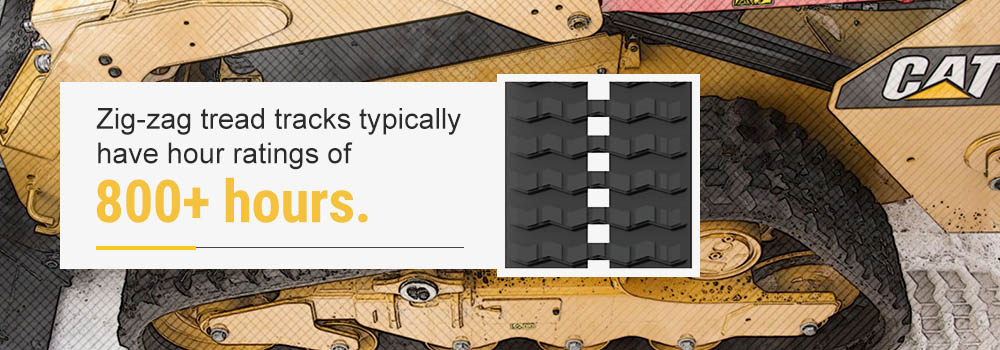
8. Hex
A hex tread pattern features hexagon-shaped pads, and it offers durability and versatility when you operate equipment on gravel, sand, solid dirt or turf. With this tread pattern, you can enjoy a comfortable, smooth ride while you work. Tracks with a hex pattern leave minimal markings on lawns and grassy surfaces. You can expect a 600+ hour rating from hex-pattern tracks.
You should avoid using tracks with a hex tread pattern if you plan to work in excessively wet conditions.
9. Technology Design Formulation
Technology design formulation (TDF) tread is a linear tread that effectively grips snowy and icy surfaces rather than digging into them. Tracks with TDF tread are ideal for applications such as snow removal or performing tasks in snowy conditions because they prevent slipping and make it easier to drive over snow or ice-covered surfaces.
Choosing the Right Rubber Track Size and Width
Track size and width determine a piece of equipment’s weight distribution and stability. While narrow tracks are ideal for maneuvering in narrow spaces, wider tracks are the best option for working on soft ground. Wider tracks can move across soft ground with minimal disturbance or damage because they distribute your equipment’s weight across a larger surface area. You should use wider tracks when protecting your work site’s terrain is a priority.
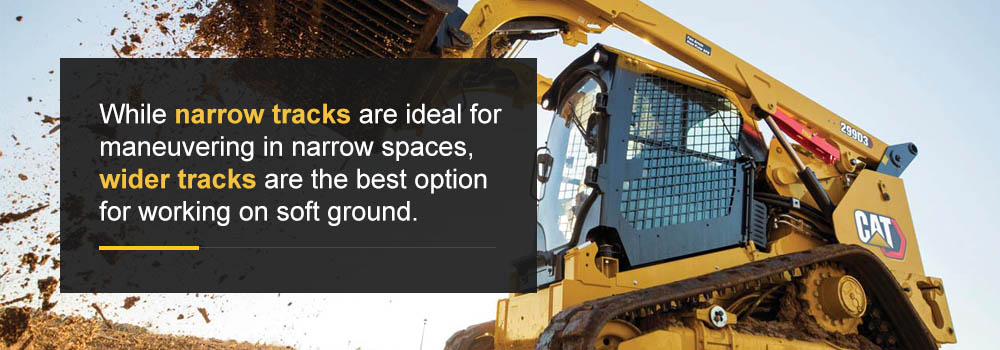
You can search for the right size replacement tracks by measuring your equipment’s current track size. Follow these steps to get an accurate measurement:
- Measure the width of the track in millimeters.
- Measure the track’s pitch in millimeters by measuring the space between the center or one lug or link to the center of another.
- Count the track’s total number of links.
- Multiply the track, pitch and links together to determine the track size.
With your current track size and your equipment’s make and model, you can begin searching for the ideal track replacements.
Why Rubber Track Composition Matters
Rubber composition is another important consideration when choosing equipment tracks. Track rubber must remain durable to withstand the elements, intense sun exposure and terrain conditions.
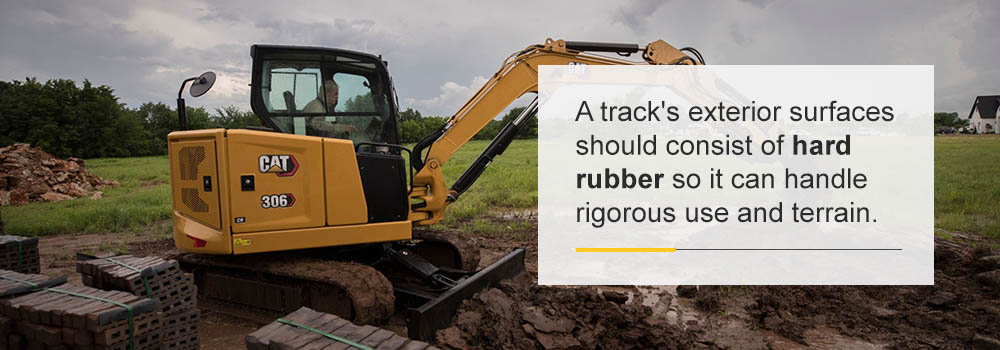
Dependable manufacturers use different types of rubber on different parts of tracks to ensure reliable performance. For example, quality tracks feature soft rubber on the interior track surface that rests against a piece of equipment’s undercarriage to provide greater track flexibility. A track’s exterior surfaces should consist of hard rubber so it can handle rigorous use and terrain.
Internal Structure and Durability
Rubber tracks include interior belts that reinforce their design and provide tensile strength. High-quality belts or cables prevent tracks from stretching, increasing durability and helping them last longer. Your skid loader or mini excavator’s durability depends on cable strength, elongation and tensile strength. Tracks may contain one of the following types of belts:
- Continuous wound cable: A continuous wound cable system is ideal for jobs and projects where you apply more torque to the treads. This type of system contains a wire that winds continuously around a track, making it the strongest option. Continuous wound cables are less important for mini excavators but offer the greatest durability. The cable will carry an evenly distributed weight as long as its circumference is straight.
- Overlapping cable ends: Tracks with overlapping cable ends contain several wire strands that manufacturers cut to length, overlap and connect with rubber. The overlap point or rubber adhesion’s strength determines the track’s strength, making overlapping cable ends slightly less reliable than continuous wound cables.
- High-strength cording: Multi-terrain track loader tracks feature embedded high-strength cording instead of steel cables. The cords serve as springs that help preserve elasticity and prevent elongation when suspension fluctuates.
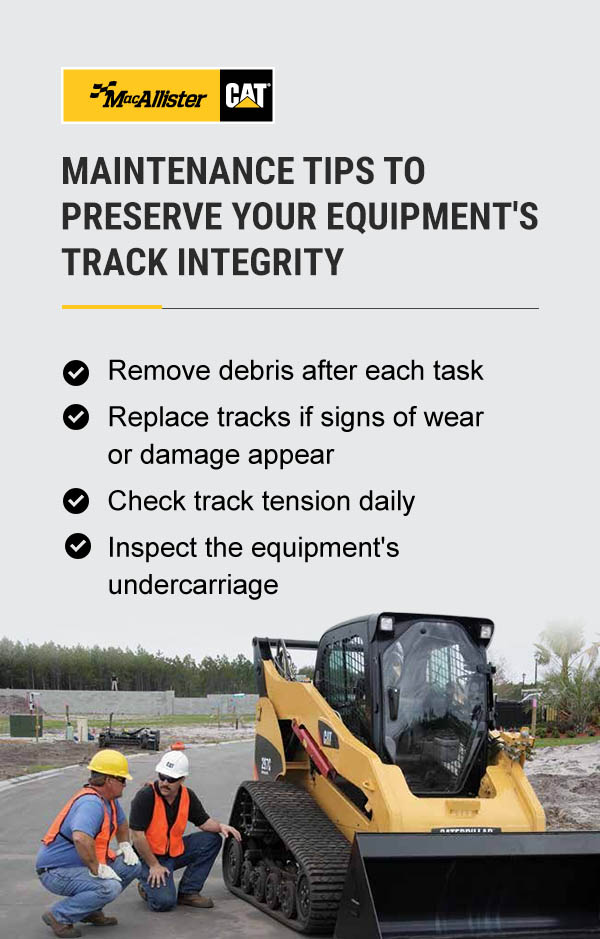 Weather Adaptability
Weather Adaptability
Your primary work location’s climate is another important consideration. For example, C-pattern tracks are perfect if you work in a climate with frequent rain. Tracks with TDF tread are the best option if you plan to use your equipment in the winter when snow and ice are likely. Having the right tracks for various weather conditions lets you keep projects going and avoid delays when inclement weather occurs.
While having the right type of tracks for your work area’s climate maximizes weather resistance, maintenance is still essential. Implement the following maintenance tips to preserve your equipment’s track integrity:
- Remove debris after each task: Debris can become lodged between track crevices, especially when operating in rough terrain or muddy conditions. Cleaning tracks and removing debris can help the tracks last longer despite operating conditions.
- Replace tracks if signs of wear or damage appear: Replacing tracks when necessary keeps your team safe and prevents further damage from affecting your equipment.
- Check track tension daily: Maintaining adequate track tension is essential because it helps reduce wear and prevent damage.
- Inspect the equipment’s undercarriage: Your tracks are part of your equipment’s undercarriage, so inspecting and maintaining each component within the undercarriage is an essential part of extending longevity.
Balancing Cost and Quality: OEM vs. Aftermarket Rubber Tracks
Equipment manufacturers design rubber tracks to fit the equipment they produce, also known as original equipment manufacturer (OEM) tracks. For example, Cat® manufactures tracks to match each skid loader and mini excavator they place on the market. Different manufacturers produce aftermarket parts, so they come from a different company than the one that built your equipment.
You can expect OEM tracks to operate with the same high-quality performance as the tracks your equipment came with. While OEM parts are more expensive than aftermarket parts, they also come with a manufacturer’s warranty. If OEM tracks become damaged, you are more likely to receive compensation or a replacement than you are if you experience a complication with aftermarket parts. Individuals and companies typically purchase aftermarket parts due to their low cost, but you can get a higher value from OEM parts.
If your top priority is saving money, you can talk to a reputable rubber track dealer like MacAllister Machinery to find the best deal. A knowledgeable dealer can help you weigh your options and find the best parts for your needs, applications and budget.
Why You Should Always Replace Tracks in Pairs
It may seem tempting to replace only one track if the other appears in good condition. However, replacing tracks in pairs is crucial because it ensures even wear. Avoiding unevenly worn tracks benefits your equipment and operations in the following ways:
- Balanced weight distribution and adequate stability
- Balanced traction
- Greater component longevity
- Optimal mobility and performance
- Operational efficiency
- Lower maintenance costs
- Damage prevention
- Fuel efficiency
- Operator and site safety
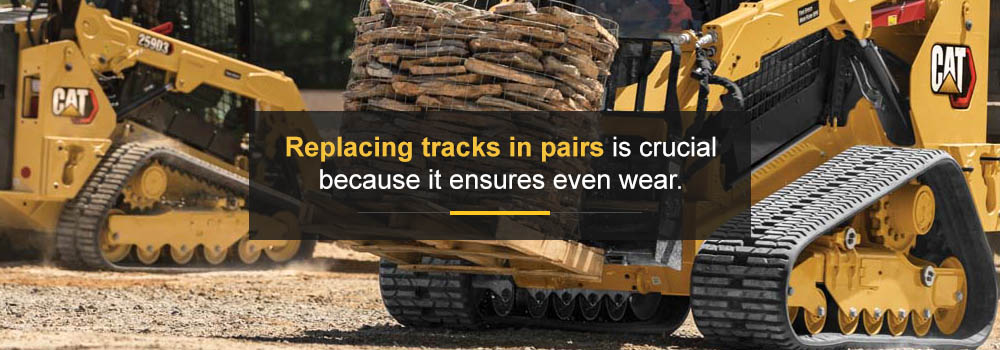
Replacing your tracks in pairs is the safest option because it helps you maintain the necessary traction to avoid damage and accidents. It’s also the most economical way to maintain tracks, as it reduces fuel consumption. Unevenly worn tracks can cause an engine to overcompensate for imbalanced traction, but evenly worn tracks allow your engine to run efficiently.
Tips for Choosing the Right Replacement Rubber Tracks
Choosing the right replacement rubber tracks may seem challenging at first, but you can make the right decision with the following tips:
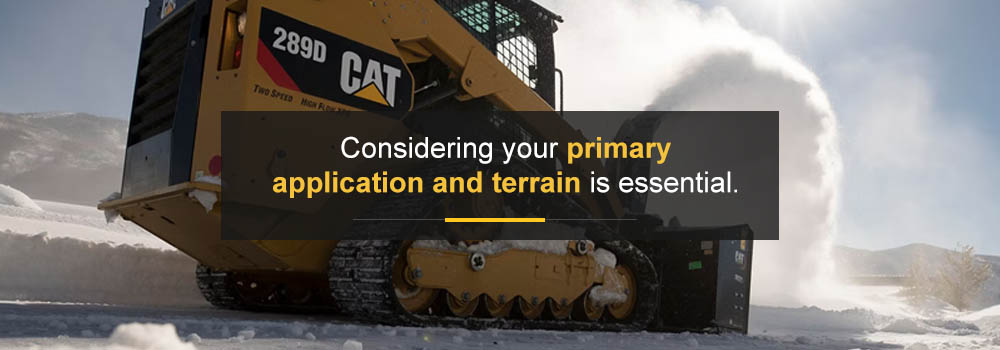
Consider Your Primary Application and Site Conditions
Since you most likely use your mini excavator or compact track loader for multiple purposes, considering your primary application and terrain is essential. Consider the ideal equipment tracks for each of the following applications:
- Construction: Construction jobs and projects typically involve heavy-duty tasks requiring strong, durable equipment. With the right tracks, you can increase productivity, complete projects on time and reduce maintenance costs. Multi-bar lug pattern tracks are the best option for performing many general construction jobs.
- Agriculture: Agricultural applications require equipment tracks with excellent traction and wear resistance. These features allow farmers to maneuver equipment on wet soil and harvest crops efficiently. The best tracks for agricultural tasks are ones with high tensile strength and deep grooves, such as C-pattern tracks.
- Landscaping: The hex pattern tread is a fantastic choice for your equipment tracks if you primarily perform landscaping work. Since they leave minimal markings on soft, grassy surfaces, hex-pattern tracks enable you to complete landscaping tasks while preserving lawn conditions and appearances.
- Snow removal: If your primary equipment use is for snow removal, a zig-zag pattern or TDF-pattern tread is the best option. Zig-zag and TDF tracks deliver fantastic traction when working in snow or on icy surfaces, significantly reducing the risk of slips, accidents and equipment damage.
Evaluate Common Terrain Challenges
While assessing your primary application is the most important part of choosing tracks for your equipment, evaluating common terrain challenges is also crucial. Think about past and upcoming project sites, and consider common conditions you may face. For example, you may complete construction work on job sites with sloped surfaces or particularly soft terrain.
Seek Professional Advice
Seeking professional advice is also crucial because a professional has the knowledge and experience to help you make an informed decision. A reputable equipment dealer can evaluate your applications, needs and job site conditions to determine the most beneficial rubber tracks for you or your company.
Find the Right Rubber Tracks With MacAllister Machinery
Choosing the right rubber tracks for your applications and operating conditions is essential. With the right track tread pattern and size, you can increase efficiency, boost productivity, keep projects on schedule and extend equipment life spans.
MacAllister Machinery offers a wide range of compact track loader and mini excavator tracks, and our experts can help you choose the best option for your needs. At MacAllister Machinery, we have the knowledge and experience to determine the ideal tracks based on your typical job site challenges and primary applications.
If you operate Cat machinery, selecting OEM Cat parts is the best way to maintain peace of mind and ensure durability. Our inventory features a wide selection of Cat equipment and parts, including Cat OEM rubber tracks. With a wide range of locations, we can help you find tracks quickly and conveniently.
At MacAllister Machinery, we provide unparalleled customer service, supporting you before, during and after your purchase. Contact us to consult with a MacAllister Machinery professional and receive professional, personalized advice on choosing the right rubber tracks for your equipment.

